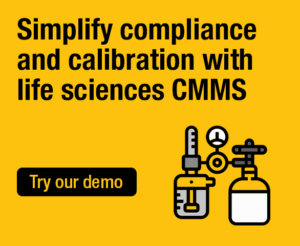 Pharmaceutical companies are held to strict standards by the United States Food and Drug Administration (FDA) and other international standards. Ensuring compliance with regulations like 21 CFR Part 11 is essential to keep manufacturing operations running smoothly and protect the health and safety of the end user. A computerized maintenance management system (CMMS) software is a powerful tool for compliance. And the best CMMS software for pharmaceuticals will also provide maintenance teams with countless other benefits.
Pharmaceutical companies are held to strict standards by the United States Food and Drug Administration (FDA) and other international standards. Ensuring compliance with regulations like 21 CFR Part 11 is essential to keep manufacturing operations running smoothly and protect the health and safety of the end user. A computerized maintenance management system (CMMS) software is a powerful tool for compliance. And the best CMMS software for pharmaceuticals will also provide maintenance teams with countless other benefits.
This post provides examples of key regulations that pharmaceutical companies must comply with and explains how a life sciences CMMS can simplify compliance, give you confidence going into an audit, and provide additional benefits that can save you time and money.
21 CFR Part 11: What Pharmaceutical Companies Need to Know
FDA Title 21 CFR Part 11 is a fundamental compliance requirement for pharmaceutical companies. 21 CFR Part 11 is enforced on biotechnology, biomedical, and pharmaceutical suppliers in the public health sector. For these highly regulated industries, every step of the manufacturing and maintenance process must be carefully and accurately documented to protect the end users’ health and safety.
21 CFR Part 11 establishes the standards for ensuring that electronic records are just as complete, accurate, and authentic as traditional paper-based records. The regulation outlines requirements for record storage and retrieval, electronic signatures, system validation and more.
Learn more about 21 CFR Part 11, or use our checklist to see how your compliance measures up.
Complying with International Pharmaceutical Regulations like ISO 13485, EudraLex Annex 11, and GLP
In addition to FDA compliance, pharma companies that do business outside of the United States must also comply with international laws and standards for the manufacturing and distribution of over-the-counter medications. For example, ISO 13485 is the international standard that specifies controls for quality management systems. In addition, the EU version of 21 CFR Part 11, known as EudraLex Annex 11, discloses how medical device manufacturers should validate their software systems.
Good Laboratory Practices (GLPs) are fundamental to confirming the identity and quality of a drug. They are in charge of monitoring drug development studies and clinical trial outcomes to approve only accurate reports. For this reason, R&D facilities are required to follow GLPs.
Every plant must adhere to Good Manufacturing Practices (GMP) under the appropriate conditions, where equipment is properly maintained, the necessary controls are put in place, and employees are qualified to do the job. GMPs are characterized by the reliability of testing procedures, detection of quality deviations, and sourcing of raw materials. GMPs are meant to eliminate traces of contamination or mistakes in labeling containers.
What is a CMMS?
A CMMS is a maintenance software that helps manage and track many maintenance processes simultaneously in a convenient central location. A CMMS makes it easier to manage manufacturing activities and data, store and access records, and generate custom reports to visualize compliance and other key performance indicators (KPIs). From a business standpoint, you can rest assured knowing that your factories are running at full capacity — and in compliance with the FDA.
Benefits of a CMMS for Pharmaceutical Manufacturing
1. Reduce Maintenance Costs
Leveraging a life sciences CMMS software and incorporating best practices for equipment maintenance gives organizations a competitive edge while reducing costs. For example, a well-executed maintenance strategy reduces time and costs associated with unplanned maintenance and downtime.
2. Keep Complete and Accurate Maintenance Records
A centralized maintenance platform helps plant supervisors schedule and document maintenance duties, keep track of individual assets, and document methods to continue moving items through the pipeline. CMMS software seamlessly handles work order approvals, and can even deliver predictive maintenance abilities that alert your staff about equipment malfunctions ahead of time. It schedules days for cleaning duties and testing of machinery.
3. Ensure Product Safety and Integrity through Computer Systems Validation
A CMMS combines maintenance, documentation, and compliance into a maintenance management dashboard. It aligns with Computer Systems Validation (CSV) standards for product safety and data integrity to convince auditors that your software has been validated for its intended use and will perform the necessary functions.
4. Approach Audits with Confidence
A CSV service speeds up CMMS validation under GxP guidelines to guarantee audit readiness. It includes features for operational qualifications, accessing records on demand, and acquiring functional specifications.
5. Maximize Uptime and Throughput
Your maintenance staff can get access to streamlined reports and audited records from nearly any location. For example, a CMMS solution can be used to notify your staff about equipment maintenance requirements before they lead to failure, unplanned downtime, or damaged product.
Maintain regulatory compliance with eMaint CMMS
Selecting the best CMMS for the pharmaceutical industry makes GMP and FDA compliance easier by keeping complete and accurate electronic records of all maintenance activities. A strong CMMS sits at the heart of any effective maintenance strategy, helping you manage maintenance and compliance while mitigating the risk of downtime.
Whether it’s FDA 21 CFR 11, ISO 13485, or other regulations, eMaint CMMS helps manufacturers in highly regulated industries improve maintenance best practices, prepare for audits or inspections, and approach audits with confidence.
Learn how eMaint simplifies the audit process and helps organizations ensure regulatory compliance. Sign up for a free demo.


